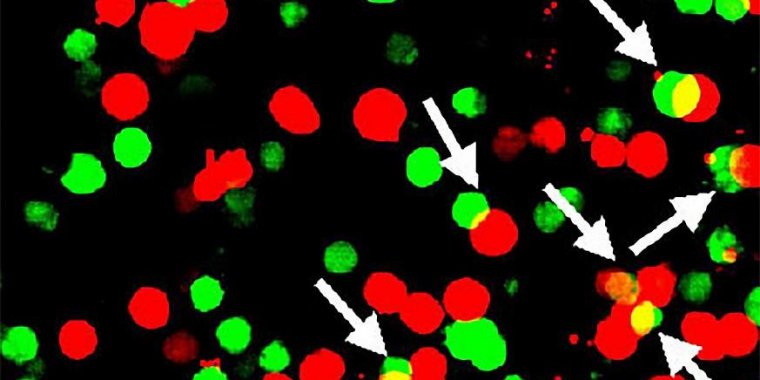| News / Science News |
‘Sticky’ gene may help Valium calm nerves
It is an increase in the number of people who died from overdoses of Valium and other benzodiazepines. For years, scientists thought that these powerful sedatives, which are used to treat anxiety, muscle spasms, and sleeping disorders, worked alone to calm nerves. Now researchers from the National Institutes of Health show that this view of the drugs and the neural circuits they affect may have to change. In a study of mice, scientists discovered that both may need the assistance of a ‘sticky’ gene, named after a mythological figure, called Shisa7.

In a study of mice, NIH researchers showed that a protein encoded by a gene called Shisa7 (green) may boost the nerve calming effects of valium and other benzodiazepines by sticking to GABA type A neurotransmitter receptors (red). Photo: Lu lab, NIH/NINDS
Researchers studies the genes and molecules used to control synapses; the trillions of communications points made between neurons throughout the nervous system, to look at synapses that rely on the neurotransmitter gamma-aminobutyric acid (GABA) to calm nerves.
Communication at these synapses happens when one neuron fires off packets of GABA molecules that are then quickly detected by proteins called GABA type A (GABAA) receptors on neighboring neurons.
Before this study, it was thought that benzodiazepines worked alone to boost the nerve calming responses of GABAA receptors. Researchers found that, instead, these responses may depend greatly on whether a protein encoded by the Shisa7 gene is stuck to GABAA receptors.
In 2004, Japanese researchers originally discovered that the Shisa gene played a role in the formation of frog heads and, named the gene after a mythological, large-headed, guardian figure depicted in statues throughout southern Japan.
Scientists thought that Shisa7 played a role in controlling a completely different type of synapse that relies on the neurotransmitter glutamate to excite, rather than quiet, neurons.
Recent studies suggested that Shisa7 along with other Shisa genes encodes proteins that adhere to glutamate receptors. Once attached, these “auxiliary” proteins can control a receptor’s response to glutamate or its presence at synapses.
The researchers used advanced microscopic techniques to spot Shisa7 tightly clustered with GABAA receptors at synapses. Genetically eliminating Shisa7 from neurons reduced the number of GABAA receptors and decreased the strength of electrical currents generated by synaptic GABAA receptor responses.
Further experiments suggested that Shisa7 proteins attached directly to GABAA receptors. Electrical recordings showed that Shisa7 hastened receptor responses to the transmitter GABA and nearly doubled the size of responses made in the presence of Valium (a.k.a. diazepam), suggesting the protein made the receptor more sensitive to benzodiazepines.
Experiments in mice supported the idea that Shisa7 also plays a role in the calming effects of benzodiazepines.
In other experiments, the researchers found that Shisa7 also influenced the drowsiness and hypnotic effects of benzodiazepines. Mice that lacked Shisa7 were much less likely than wild-type mice to fall asleep from high levels of diazepam.
Moreover, the mutant mice were dramatically better at standing up after diazepam-induced stumbles, in fact, some appeared resistant to stumbling. (National Institutes of Health)
YOU MAY ALSO LIKE





